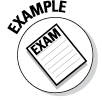Introduction
Welcome to GRE For Dummies, Premier 7th Edition. Don’t take the dummies thing personally — you’re obviously no dummy. You made it through high school with high enough grades and test scores to get into college. You then graduated to join the elite group of approximately 25 percent of U.S. citizens 25 years or older who hold bachelor’s degrees. And now you’re standing at the entrance of graduate school.
Between you and your goal is the GRE: a test designed solely to challenge your ability to remember everything you’ve forgotten since high school — material you haven’t touched in years. To clear this hurdle, all you really need right now is a refresher course. Well, here it is: GRE For Dummies, Premier 7th Edition, is your refresher course plus. This book goes beyond simply rehashing what you’ve learned and forgotten and provides valuable strategies and tips for answering questions more efficiently and improving your odds of answering correctly. In this book, you also find plenty of examples, practice questions, and practice tests to hone your skills, identify subject areas you need to work on a little more, and build your confidence for test day.
Like a personal guide, this book reveals the ins and outs of the GRE and secret passageways to reach your goal: admittance to the grad school of your choice and perhaps a scholarship to help pay your way. The purpose of this book is to help you learn what’s necessary and useful for scoring high on the GRE. Period. No extra garbage is thrown in to fill space; no filler is added to make this book the fattest one on the market. If you need esoteric (hard to understand) or irrelevant material, go to the GRE shelf of your local library — you’ll find plenty. If you need a fast, effective guide to acing the GRE, you’re holding the right book.
About This Book
In GRE For Dummies, Premier 7th Edition, I cover all the basic math and verbal concepts and introduce some actual GRE-type questions to practice with. I also show you how to approach each type of question, recognize the traps built into the questions, and master the tricks that help you avoid those traps.
To earn a top score on the GRE, you must achieve two goals, one primary and one secondary:
 Primary goal: Master everything the test covers. Read through the whole book. No matter how well you know a specific subject, you can improve, and you need to make sure you have the knowledge and skills to handle each section at GRE level. Believing you should work on only your weakest sections is a mistake. The GRE measures your overall and top skill levels, so building on your strengths is just as important as improving in your weakest subject areas.
Primary goal: Master everything the test covers. Read through the whole book. No matter how well you know a specific subject, you can improve, and you need to make sure you have the knowledge and skills to handle each section at GRE level. Believing you should work on only your weakest sections is a mistake. The GRE measures your overall and top skill levels, so building on your strengths is just as important as improving in your weakest subject areas.
 Secondary goal: Strengthen your most challenging subject areas. Turn to specific sections for targeted information and help. The organization of this book makes it very easy to find the type of math questions you always have trouble with, suggestions for answering Reading Comprehension questions without having finished the passage, and tricks for acing the sentence-based questions.
Secondary goal: Strengthen your most challenging subject areas. Turn to specific sections for targeted information and help. The organization of this book makes it very easy to find the type of math questions you always have trouble with, suggestions for answering Reading Comprehension questions without having finished the passage, and tricks for acing the sentence-based questions.
This book is not only simple and straightforward enough for those who are rusty with the math and verbal but also detailed and sophisticated enough to deliver the more complicated information necessary to get truly excellent scores. For additional practice, this Premier Edition comes with a CD-ROM that includes five practice tests and 500 vocabulary flashcards based on the words featured in Chapter 7.
Conventions Used in This Book
To help you through this book, I use the following conventions:
 All GRE vocabulary words appear like this. This special font indicates a vocab word that you may not know, followed directly by its meaning. (Here’s a handy tip: Stamp these words in your memory by trying to use them in everyday life. Call your roommate or your children indolent, lethargic, and listless when they don’t clean up after dinner, or promise your professor or boss you’ll be diligent, meticulous, and painstaking in your next assignment.)
All GRE vocabulary words appear like this. This special font indicates a vocab word that you may not know, followed directly by its meaning. (Here’s a handy tip: Stamp these words in your memory by trying to use them in everyday life. Call your roommate or your children indolent, lethargic, and listless when they don’t clean up after dinner, or promise your professor or boss you’ll be diligent, meticulous, and painstaking in your next assignment.)
 All web addresses appear in
All web addresses appear in monofont.
 Multiplication signs vary throughout the book, including the × symbol, as in 2 × 2 = 4; two side-by-side numbers or expressions each enclosed in parentheses, such as (2)(5) = 10; or occasionally a dot, as in x · x = x2. I use the dot in expressions that contain the variable x to preclude (prevent) any possible confusion with ×. Also, letters and numbers side by side without parentheses are multiplied: 2x means 2 times x.
Multiplication signs vary throughout the book, including the × symbol, as in 2 × 2 = 4; two side-by-side numbers or expressions each enclosed in parentheses, such as (2)(5) = 10; or occasionally a dot, as in x · x = x2. I use the dot in expressions that contain the variable x to preclude (prevent) any possible confusion with ×. Also, letters and numbers side by side without parentheses are multiplied: 2x means 2 times x.
What You’re Not to Read
Everything in this book is helpful, but the sidebars are more for adding levity (light manner or attitude) than for sharpening your skills and are not as essential as the other sections to your success on the GRE. If time is tight, you can skip the sidebars and still dramatically improve your exam score.
Foolish Assumptions
This book is intended to help you prepare for the GRE. I assume that you are in at least one of these three stages of your GRE planning:
 You have already scheduled the GRE, or are about to, and need some preparation before taking it.
You have already scheduled the GRE, or are about to, and need some preparation before taking it.
 You have to take the GRE for acceptance into the graduate program at your preferred school.
You have to take the GRE for acceptance into the graduate program at your preferred school.
 You’re considering a graduate program or school that requires the GRE as part of the application process and want to know what the exam is all about.
You’re considering a graduate program or school that requires the GRE as part of the application process and want to know what the exam is all about.
How This Book Is Organized
This book is divided into six parts. Forming the core are three parts sort of in the middle, each of which tackles a different section of the GRE: Verbal, Math, and Analytical Writing. Part I provides everything you need to know to develop effective test-taking strategies. Part V features several practice exams to build your confidence. And Part VI provides some valuable bonus material. The following sections describe the contents of each part in greater detail.
Part I: Mastering the GRE Test-Taking Experience
Knowing what to expect on the test significantly improves your ability to perform well. The chapters in this part reveal what’s on the test and how it’s scored, test-taking strategies to improve your performance, and a checklist of everything you need to do to prepare for test day.
Part II: Tackling the Verbal Section One Word at a Time
The Verbal portion of the GRE challenges your reading comprehension and vocabulary skills. In this part, I show you how to tackle the two types of questions in the vocabulary section: Text Completion and Sentence Equivalence. I provide guidance on how to improve your reading comprehension and quickly pick out answers to questions by referring back to the reading passage. Finally, I explain various ways to expand your vocabulary to score even higher on the test.
Part III: High School Math and Beyond: Math You Thought You’d Never Need Again
GRE math, with little exception, is based very much on what you studied in high school. However, mastery of the math concepts alone won’t get you a top math score. The GRE Math section challenges your ability to solve problems and recognize the underlying concepts. For example, the GRE expects you to know that squaring a proper fraction makes the number smaller, not larger, even if you don’t know what the fraction actually is. In Part III, I review all these concepts with you, starting with basic arithmetic and covering geometry, algebra, word problems, charts and graphs, and quantitative comparisons, plus problem-solving strategies.
Part IV: Penning Powerful Analytical Essays
Your GRE experience begins with two essays. Your goal on the essays is twofold: Meet the requirements of the essay evaluators and write the essays without exhausting yourself. This second part is crucial so you conserve enough brain power for the rest of the test. In Part IV, I show you an easy, step-by-step process for writing killer essays so you can meet the evaluators’ requirements with minimal effort.
Part V: Taking Full-Length Practice GREs: It’s All You
Not only do you need to master the skills used for the test, but you also need to be able to use these skills well in the test-taking environment. In other words, you need to be at your best for nearly four hours. Though all students can build their skills through full-length practice tests, students with test anxiety especially benefit from practice. The goal in Part V is to make the test-taking experience as familiar as possible so that on test day, very little — if anything — surprises you.
Part VI: The Part of Tens
In the Part of Tens, I provide additional insights and tips to further improve your performance, including facts about the GRE, common mistakes to avoid, and good ways to warm up on test day. Though not specific to any one part of the GRE, Part VI is geared toward ensuring that you perform your absolute best on the day of the test.
CD-ROM
The companion CD contains electronic versions of the practice tests in this book and two additional practice tests. You can take untimed versions of the tests for extra practice with the material, or you can take timed versions to simulate the real testing experience. The CD also offers 500 vocabulary flashcards to help you expand your vocabulary for the GRE.
Icons Used in This Book
Although everything included in this book is valuable, some tidbits call for special attention. Look for the following icons to quickly spot the most important information on the page.
Where to Go from Here
Everything in this book is relevant to helping you get a firm understanding of the GRE. Whether you’re strong or weak in any of the subject areas, you definitely want to practice the strategies and work the different question types of the entire test and, therefore, this entire book. Naturally, spend more time on your weak areas, and try to go through this book from start to finish, paying special attention to the practice tests.
I’ve been helping GRE students beat the test for years, so not only do I know your common questions and mistakes, but I also know how to make the math and verbal questions easier for you to answer. This book distills my tricks and secrets, which I’m pleased to share with you. Your success, after all, is why we’re both here.



